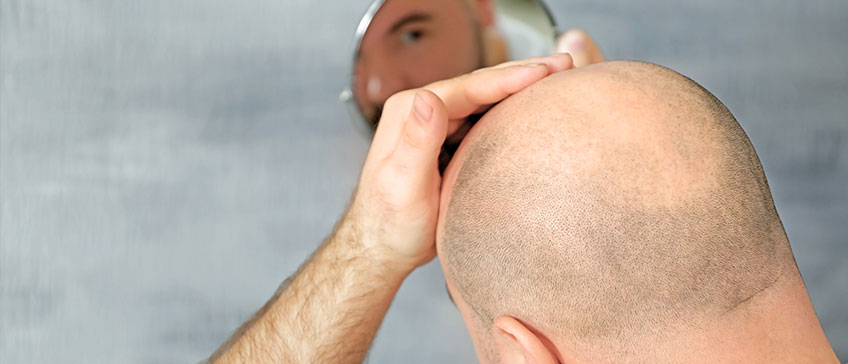Gubitak kose estetski je problem zbog kojega ljudi mogu osjećati veliki stres, nelagodu i frustraciju. To nije neobično - u našim svakodnevnim kontaktima prvo su što zamjećujemo lijepa i njegovana kosa, osmijeh i izgled lica.
Iako je gubitak kose kod muškaraca nešto učestaliji i žene nerijetko pate od ovog problema. Međutim, ženski i muški tip ćelavosti razlikuju se po mjestima gubitka kose, intenzitetu i dobi u kojoj započinje ovaj proces.
Moderne metode estetske medicine koje radimo u Poliklinici Bagatin mogu pomoći u borbi protiv gubitka kose kod žena i muškaraca te vratiti samopouzdanje i zadovoljstvo ljudima pogođenim ovim problemom.
Parcijalan ili potpun gubitak kose nazivamo alopecija. Ovo stanje može biti uzrokovano nasljednim faktorima, autoimunim bolestima, hormonalnim poremećajima i stresom.
Što je alopecija?
Ispadanje kose normalan je dio životnog ciklusa vlasi. Svaka vlas prođe kroz tri faze - rasta, mirovanja i ispadanja. Nakon ispadanja iz folikula odmah raste nova vlas pa se kosa kontinuirano obnavlja. Svatko od nas primijetit će opadanje kose pri pranju ili češljanju. Izgubiti dnevno 70 – 100 vlasi je potpuno u redu – sve dok zdravim tempom raste nova kosa.
No, ako gubitak postane izraženiji, pa na vlasištu primijetimo prorjeđivanje ili cijele regije bez kose, očito je kako je došlo do nekog poremećaja. U tom je slučaju potrebno čim prije zatražiti pomoć dermatologa.
Liječnik dermatolog u Poliklinici Bagatin postavit će dijagnozu u pozadini opadanja kose, poučiti vas kako odabranim tretmanima spriječiti opadanje kose i pomoći oporavku kose te odgovoriti na najčešće pitanje naših pacijenata - postoji li za opadanje kose lijek.
Nakon pregleda i dijagnoze uzroka opadanja kose, možemo vam ponuditi nekoliko tretmana, među kojima je i najsuvremenija metoda FUE transplantacija kose koja s velikim uspjehom vraća izgubljenu kosu.
Vrste alopecije
Poznajemo niz vrsta alopecija, a najraširenije među njima su androgena alopecija i alopecija areata.
Androgena alopecija
Ova vrsta alopecije najčešće pogađa muškarce. Događa se zbog negativnog djelovanja muških hormona na folikul dlake. Budući da i žene imaju muške hormone, javlja se i kod žena, posebice prilikom hormonalnih promjena (nakon poroda, u menopauzi i sl.).
Dakle, hormon testosteron djeluje i na muške i na ženske dlake jednako, što ovisi o genetskoj predispoziciji folikula, tj. koliko je osjetljiv na hormon.
Alopecija areata
Alopecija areata stvara pojedinačna ili višestruka ovalna žarišta, najčešće na vlasištu ili i na drugim dijelovima tijela. Teži oblici mogu dovesti do potpune ćelavosti.
Telogeni efluvij
Ovaj oblik gubitka kose prorjeđuje kosu na cijelom vlasištu i vodi prema ćelavosti. Većinom je riječ o naglom i kompletnom gubitku kose. Ovo stanje dovodi do toga da dlake prerano ulaze u fazu mirovanja (telogenu fazu), a zatim ispadaju, pa se kosa ne stigne obnoviti. Javlja se uslijed nedostatka nutrijenata, uzimanja nekih vrsta lijekova, hormonskih promjena ili izloženosti visokoj razini stresa. Posebno se može dogoditi ako žena boluje od sindroma policističnih jajnika, nakon poroda i u menopauzi kad opada koncentracija estrogena.
Univerzalna alopecija (Alopecia universalis)
Osobe pogođene ovom vrstom alopecije gube sve dlake na tijelu. Osim estetskih problema, gubitak dlaka u nosu i oko očiju predstavlja i zdravstveni rizik, jer one imaju funkciju zaštite sluzokože od vanjskih utjecaja.
Totalna alopecija (Alopecia totalis)
Kod ovog oblika alopecije dolazi do totalnog gubitka kose, ali dlake na tijelu ostaju očuvane. Alopecia totalis javlja se u dva oblika - kao nagli i iznenadni gubitak kose ili kao postepeno stanje koje započinje mjestimičnim gubitkom kose (kao Alopecija areata) i na kraju dovodi do potpunog gubitka kose.
Ofijaza (Ophiasis)
Ovo je varijanta alopecije areate kod koje dolazi do gubitka kose u valovitom obliku oko cijele glave.
Alopecija uslijed čupanja kose
Ako se kosa jako nateže u repovima, pletenicama ili drugim vrstama frizura, može se dogoditi oštećenje folikula i korijena kose, što s vremenom dovodi do ispadanja vlasi. Podvrsta ove alopcije je Chignon alopecija – ispadanje kose na vrhu glave uslijed natezanja kose u čvrstu punđu. Ovakvo ispadanje kose ponekad pogađa balerine koje redovito nose vrlo čvrste punđe.
Trihotilomanija
Ovo je jedan od oblika opsesivno-kompulzivnog poremećaja u kojem osoba čupa kosu, što obično ostavlja pojedina žarišta bez kose.
Folikulitis
Folikulitis je bakterijska infekcija koja izaziva iritaciju folikula, što dovodi do osjetljivosti i ispadanja kose.
Uzroci alopecija
Ispadanje kose javlja se kod žena i muškaraca, stvarajući jednak nivo stresa, frustracije i nelagode. Ipak, gubitak kose ima snažna spolna obilježja, pa zamjećujemo razlike u tipu ćelavosti i uzrocima kod muškaraca i kod žena. Dok muškarci ponekad mogu prihvatiti gubitak kose kao dio svog muškog identiteta, kod žena gubitak kose iznimno negativno djeluje na samopouzdanje i zadovoljstvo.
Muškarci najčešće gube kosu uslijed androgene alopecije, a kosa se prorjeđuje najprije na zaliscima i tjemenu, a postepeno može doći do gubitka kose na cijelom vlasištu, osim na zatiljku i iza sljepoočnica. Prema nekim statistikama, gubitak kose pogađa i do 80 % muškaraca.
Kod žena, kosa se razrjeđuje na tjemenu uslijed hormonskih promjena, oboljenja, stresa ili izloženosti toksinima iz okoline. Smatra se kako se gubitak kose javlja kod oko 30 % žena.
Androgena alopecija obuhvaća 90 % svih alopecija. Javlja se pod utjecajem androgena, muškog spolnog hormona poput dihidrotestosterona. Iako je češća u muškaraca, ova alopecija javlja i kod žena.
Androgeni skraćuju anagenu fazu – fazu rasta kose, pa pod utjecajem testosterona vlasi brže i sve češće ispadaju, što u konačnici dovodi do gubitka kose i ćelavosti.
Kod muškaraca alopecija može obuhvatiti cijelo vlasište i dovesti do potpune ćelavosti ili može poštedjeti dijelove kose, obično na potiljku i području iza sljepoočnica. Više od 90 % muškaraca u dobi od 60 godina pati od neke vrste androgene alopecije.
Kod žena se kosa obično razrjeđuje na tjemenu.
Alopecija areata je drugi najčešći oblik ćelavosti. Prepoznaje se prema žarišnom ispadanju dlaka s vlasišta ili drugih dijelova tijela, a podjednako se javlja i kod muškaraca i kod žena.
Iako nije potpuno poznat uzrok ove vrste alopecije, čini se kako je riječ o poremećaju u imunološkom sustavu koji dovodi do toga da stanice imunološkog sustava napadaju folikule i tako dovode do pretjeranog i prebrzog ispadanja vlasi i dlaka.
Često je riječ o stanju koje se javlja nakon perioda izloženosti velikim stresovima. Zamijećeno je i kako se češće javlja ako osoba ima povišena antitijela štitnjače.
Srećom, u mnogo je slučajeva alopecija areata privremeno stanje pa će kosa ponovno narasti u 90 % slučajeva, a u 50 % slučajeva to će se dogoditi unutar godine dana.
Liječenje alopecije
Androgenu alopeciju može se liječiti lijekovima (minoksidilom, finasteridom, antiandrogenima ili estrogenima), ali s obzirom na to da su ti lijekovi potencijalno toksični, odluku o njihovom uzimanju mora donijeti specijalist dermatolog.
Osnovna terapija za alopeciju areatu obično su kortikosteroidi koji ponekad mogu zaustaviti napredovanje alopecije i pomoći očuvanju kose.
Mezoterapija je nekirurška i minimalno invazivna metoda estetske dermatologije koja obnavlja vlasište, potiče rast kose i ojačava kosu. Riječ je o koktelu vitamina, minerala, hijaluronske kiseline i drugih aktivnih tvari koji se tankim iglama ubrizgava direktno u vlasište. Ova metoda koristi se više od šezdeset godina s velikim uspjehom za obnovu kose, ali i pomlađivanje kože lice i tijela.
Terapija prorijeđene kose vlastitom krvlju je inovativna metoda u kojoj se potiče obnova vlasišta ubrizgavanjem vlastite krvne plazme. Trombociti, bio-aktivne tvari i faktori rasta koji se prirodno nalaze u krvnoj plazmi jako kvalitetno pomažu pri regeneraciji kose, ali i svih drugih tkiva.
Ponekad je u borbi s alopecijom dovoljna jedna od metoda, a ponekad liječnik može preporučiti kombinaciju tretmana kako bi se zaustavilo napredovanje gubitka kose, odnosno kako bi se kvalitetno obnovilo izgubljenu kosu.
Najčešća pitanja
Koji su uzroci alopecije?
Androgena alopecija javlja se pod utjecajem androgena, muškog spolnog hormona (npr. dihidrotestosterona). Češća je u muškaraca, ali se pojavljuje i kod žena uslijed pada razine estrogena, npr. nakon poroda, u menopauzi ili uslijed sindroma policističnih jajnika.
Uzroci alopecije areate nisu još posve istraženi, ali vjeruje se kako je riječ o nekoj vrsti imunološkog poremećaja koji dovodi do toga da imunološke stanice napadaju folikule.
Vjeruje se kako alopecija areata i androgena alopecija imaju genetsku podlogu, dok se kod drugih alopecija radi o kombinaciji okolišnih faktora, oboljenja, konzumacije lijekova, infekcija ili mehaničkim uzrocima (čupanje kose stegnutim frizurama ili radi trihotilomanije, psihičkog poremećaja).
Koliko brzo alopecija napreduje?
Alopecije mogu započeti naglo i brzo napredovati ili se razvijati polako, mjesecima ili čak godinama. Muškarci tipično počinju gubiti kosu u mlađoj dobi, dok je kod žena gubitak kose obično vezan uz srednju dob.
Koje su različite vrste alopecije?
Androgena, alopecija areata, telogeni efluvij, univerzalna alopecija (Alopecia universalis), totalna alopecija (Alopecia totalis), ofijaza (Ophiasis), alopecija uslijed čupanja kose, trihotilomanija, folikulitis.
Je li alopecija nasljedna?
Neke vrste alopecije, prije svega androgena alopecija i alopecija areata, imaju nasljednu osnovu i javljaju se kao rezultat međudjelovanja genetskih i okolišnih faktora.
Koje su mogućnosti liječenja alopecije?
Najbolje rješenje za izgubljenu kosu uslijed alopecije u najvećem je broju slučajeva transplantacija kose FUE metodom.
Uz transplantaciju, stručnjaci preporučuju i mezoterapiju te terapiju matičnim stanicama. Ovi tretmani dubinski hrane i oporavljaju folikule i sve stanice vlasišta pa pomažu očuvanju i ponovnom rastu vlasi.
Androgenu alopeciju može se liječiti lijekovima (minoksidilom, finasteridom, antiandrogenima ili estrogenima), ali s obzirom na to da su ti lijekovi potencijalno toksični, odluku o njihovom uzimanju mora donijeti specijalist dermatolog.
Važno je napomenuti da su u Poliklinici Bagatin ovi lijekovi dostupni u obliku spreja ili gela za lokalnu primjenu čime se ostvaruje jednako učinkovit poticaj za rast kose, ali bez popratnih nuspojava koje se mogu javiti kada ove lijekove uzimamo u obliku tableta. Lokalna primjena navedenih sprejeva i gelova preporuča se nakon transplantacije kose barem godinu dana po učinjenoj transplantaciji s terapijom prorijeđene kose vlastitom krvlju.
Osnovna terapija za alopeciju areatu obično su kortikosteroidi koji ponekad mogu zaustaviti napredovanje alopecije i pomoći očuvanju kose.
Besplatne online konzultacije s našim doktorima
Pošaljite upitObratite nam se s povjerenjem
telefonski na broj +385 1 46 10 225 ili prijavom na naš online obrazac!
Zatražite svoj termin za konzultacije, zahvat ili tretman putem našeg sigurnog online obrasca.
Naše osoblje kontaktirati će Vas u roku 24 sata putem telefona ili maila, i ponuditi termin koji Vam najviše odgovara.
Ostavite poruku
Radno vrijeme
| Telefon:* | +385 1 46 10 225 | |
| * Jedinstven broj za sve Poliklinike | ||
| Email: | info@bagatin.hr | |
Lokacije
| Green Gold Tower Ul. Grada Vukovara 269a/10, 10000 Zagreb |
|
| Donji grad Frana Folnegovića 1c/1, 10000 Zagreb |
|
| Dioklecijan Hotel & Residence Kranjčevićeva 45/1, 21000 Split |
Gdje parkirati
| Parkiranje u podzemnoj garaži Green Gold centra, Zagreb. Za detaljnije informacije preuzmite kartu |

